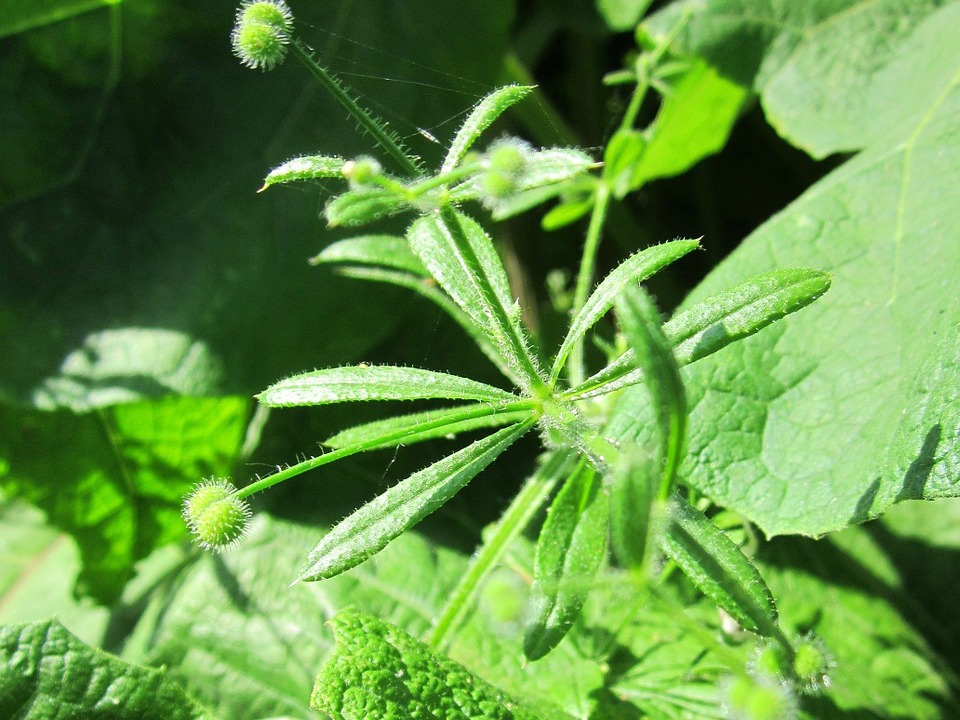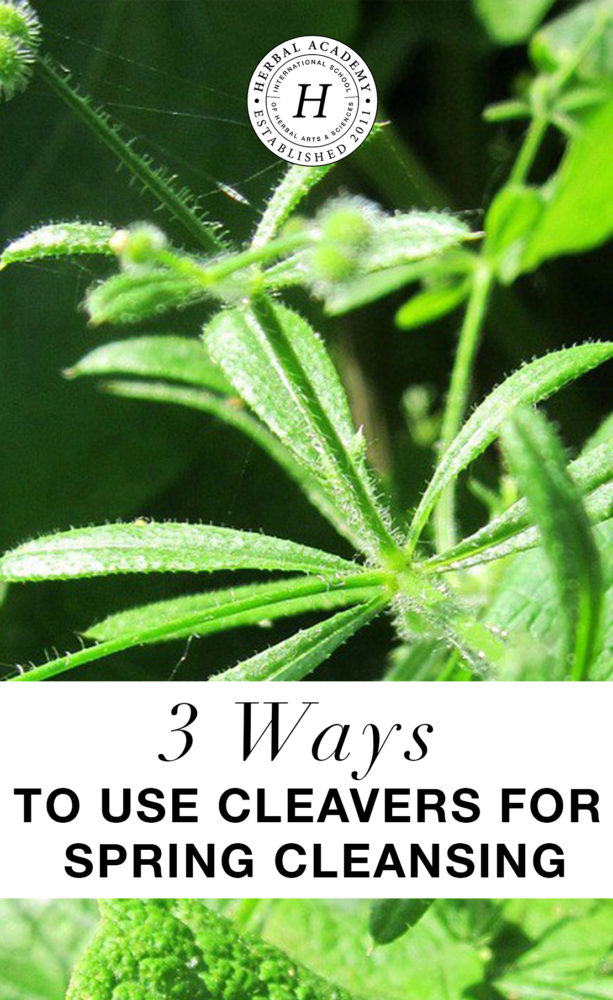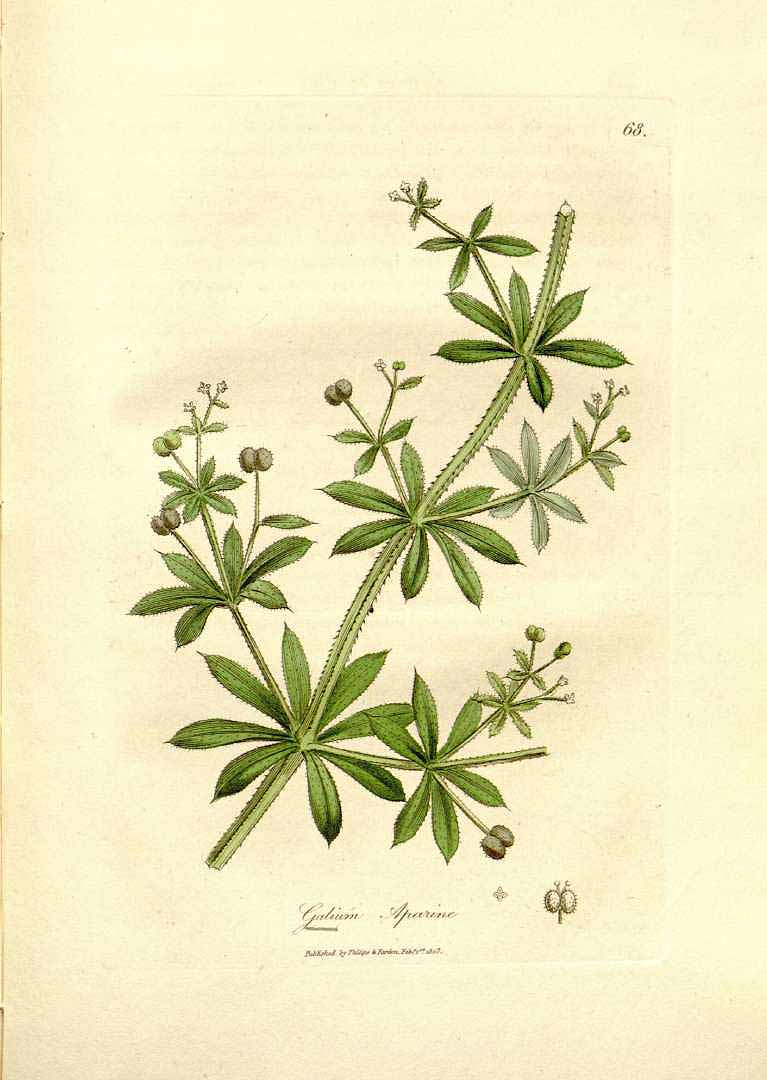
3 Ways to Use Cleavers for Spring Cleansing
Herbal greens like plantain and chickweed that begin to emerge as soon as the snows melt are fairly well known, but there is another spring weed that is good to know when you feel the need for a gentle spring tonic. A native of Europe that has spread to many parts of North America, cleavers, or Gallium aparine, also goes by such unusual names as goosegrass and sticky Willy.
The whorls of narrow, finger-like leaves make this little weed quite distinctive, but when you touch it you will immediately feel this herb’s other distinctive feature. Thanks to tiny hairs all over the surface of the leaves, cleavers will cling to you!
This spring tonic, Galium aparine, is related to sweet woodruff, lady’s bedstraw, and madder. Surprisingly, this means that it is part of the Rubiaceae, or coffee, family (Wood, 2008). But what makes cleavers such a treasured springtime ally?
Cleavers and Cleansing
Cleavers has two abilities that make it a traditional spring tonic. Herbalists describe it as an alterative and as a lymphatic tonic (Hoffmann, 2003).
An alterative is an herb that gradually restores proper function to the body and increases overall health and vitality, and may do so by promoting the ability of the body to eliminate waste through the main elimination channels of the kidneys, skin, liver, or lungs (Hoffmann, 2003).
A lymphatic, also sometimes called a lymphagogue, is an herb that supports or stimulates the lymphatic system (Tilgner, 1999).
Cleavers begins to sprout when our immune systems may be tired and sluggish from a long winter. This little garden weed can be used whenever we feel the need for a little extra immune system support, and has the perfect timing to help us as a spring tonic and cleanse.
Because exposing cleavers to the heat of boiling may harm the beneficial activity of the plant (Cech, 2000), it’s best to use cleavers as either a cold infusion, a fresh pressed juice (also called a succus), or as an infused oil for topical use.
3 Ways to Use Cleavers for Spring Cleansing
Cold Infusion of Cleavers
To make a cold infusion of cleavers, you will need:
- A chopstick
- A small muslin drawstring bag
- A quart-sized canning jar
Directions:
- Place one or two tablespoons of finely chopped, fresh cleavers (the leaves and stems, not the roots) into the muslin bag.
- Fill the quart canning jar with cool water, and use the chopstick to suspend the drawstring bag in the water. The water with more precipitates from the fresh herb juices sinks to the bottom and creates a circulation of the water as the cleavers infuses.
- Allow the cleavers to infuse overnight, or eight to twelve hours.
- As a food safety precaution, place your cleavers infusion in the refrigerator. Room temperature (or any temperature within 40-140 degrees Fahrenheit) is the bacterial “danger zone” when foodborne pathogens reproduce most rapidly.
Preserved Cleavers Juice
Not all herbs are good candidates for making a succus, or preserved juice, but cleavers is one of the ideal herbs for this purpose. Harvest a bowlful of fresh cleavers, and use a blender or food processor to reduce the herbs into a pulpy mash. You may find that it is necessary to chop the herb prior to placing it in the blender and/or add about a tablespoon of water to the blender before it can do a decent job.
Once the herb is ready, place a large piece of muslin into a colander or mesh strainer over a mixing bowl. Scoop the mashed cleavers into the center of the cloth and create a bundle with the cloth. Place a weight onto the bundle to press out the juice. A gallon jug of water works well if your colander is large enough, or you can use a small saucepan filled with a few canned goods.
After an hour or so, check on the juice in the bowl. Twist the bundle as hard as you can to press out the last few drops of liquid. Measure the amount of resulting juice and add an equal amount of vodka to preserve your succus. You can also use 3 parts juice to 1 part grain alcohol as well.
Bottle your succus in a clean, amber jar and make sure to label it with the date and contents. Your succus should be shelf stable for at least a year. A serving size is 30-60 drops (¼ to ½ teaspoon).
Cleavers Infused Oil
A cleavers oil can be used as part of a gentle massage to support the health of the lymphatic system, or a small amount can be smoothed over the skin just before bed. You might wish to focus on areas where lymph glands are located.
To make an oil with cleavers, it’s best to use dried cleavers to make an infused oil at room temperature rather than using fresh cleavers. Sterilize a glass canning jar and allow it to dry completely. Fill your jar about one-third of the way with cleavers, and then fill the remainder of the jar with a carrier oil such as almond oil or jojoba.
Cap the jar and allow your oil to sit for two weeks, making sure to shake the oil every day. When your infused oil is ready, strain the oil (a jelly bag on a stand over a clean bowl works very well for this), and bottle in a clean jar. Label and date your creation so that you don’t forget what it is.
If you use extra virgin olive oil as your carrier oil, you can even reserve part of your finished oil to make a cleavers vinaigrette to drizzle over your salads! Otherwise, make sure to state on your label that your oil is for external use only.

Spring Herbal Allies
As an infusion, a succus, or an oil, cleavers is a versatile and gentle ally that can help us support our best health in any season, but especially the season of spring.
There are many other spring allies that may be growing right under your feet. Come learn more about herbs like plantain, dandelion, and chickweed by joining The Herbarium! With in-depth articles that you won’t find anywhere else, members-only discounts, and a searchable plant profile database full of well written and thoroughly researched monographs, The Herbarium helps you continue to deepen your herbal knowledge no matter where you are on your herbal journey.
Have you used cleavers for spring cleansing? If so, how did you use them? Tell us about it in the comments below!
REFERENCES
Cech, Richo. (2000). Making plant medicine. Williams, OR: Horizon Herbs.
Hoffmann, David. (2003). Medical herbalism: the science and practice of herbal medicine. Rochester, VT: Healing Arts Press.
Tilgner, Sharol. (1999). Herbal medicine from the heart of the earth. Creswell, OR: Wise Acres Publishing.
Wood, Matthew (2008). The earthwise herbal. Berkeley, CA: North Atlantic Books.









